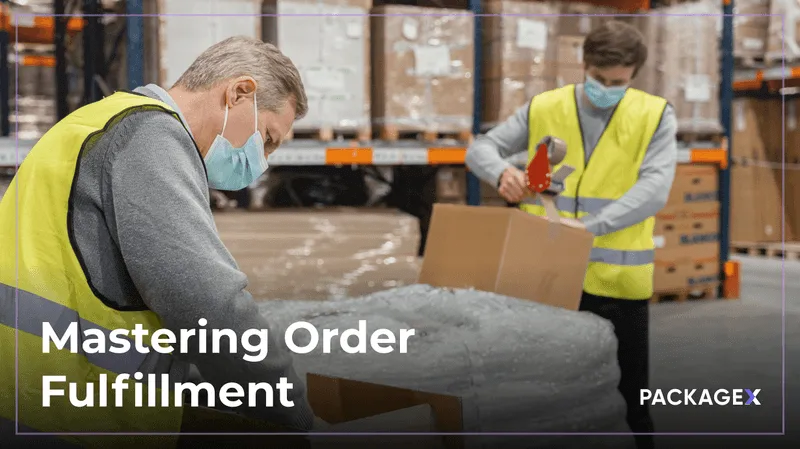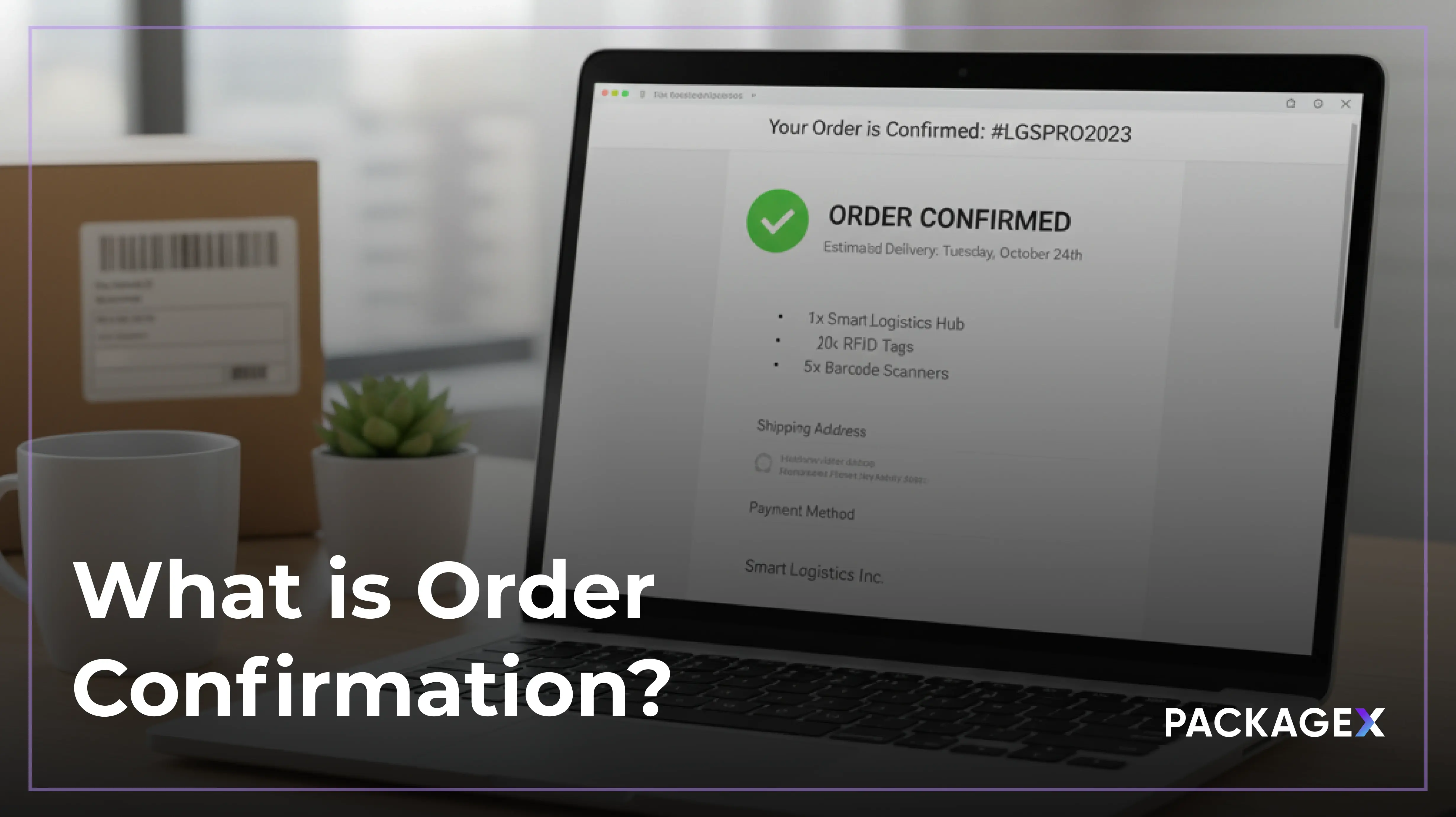Imagine ordering a product online and waiting weeks for its arrival.
Chances are, you'd think twice before purchasing from that retailer again. With online shopping becoming the norm, efficient order fulfillment is not only a backend operation, it directly impacts customer satisfaction and business success. Studies reveal that 38% of online shoppers will abandon their order if the delivery will take longer than a week.
Furthermore, as reported by Meteor Space, a staggering 98.1% of e-commerce consumers say that their delivery experience affects their loyalty to a brand. These figures highlight the critical role that streamlined order fulfillment plays in meeting customer expectations, business efficiency, and brand loyalty.
What is Order Fulfillment?
Order fulfillment refers to the complete process of receiving, processing, and delivering customer orders in e-commerce. This includes managing inventory, picking and packing products, shipping, and handling returns.
An efficient order fulfillment software ensures that customers receive the correct products promptly, which is crucial for maintaining satisfaction and encouraging repeat business. For instance, studies have shown that 38% of consumers will abandon their order if the delivery takes longer than a week, highlighting the importance of a streamlined fulfillment process
In the e-commerce supply chain, effective order fulfillment is vital. It directly influences customer loyalty and operational efficiency. By implementing streamlined order fulfillment strategies, businesses can reduce processing times, minimize errors, and improve overall customer satisfaction, leading to increased profitability.
The Order Fulfillment Process
Efficient order fulfillment is vital for customer satisfaction and business success. A well-structured approach ensures the timely and accurate delivery of products. Here's a breakdown of the key steps involved:
1. Receiving Inventory
The process begins when new stock arrives at the warehouse. Each shipment is carefully checked against purchase orders to confirm accuracy. This step is crucial for maintaining inventory integrity and preventing discrepancies. Implementing a robust inventory management system can automate this verification, reducing errors and saving time.
2. Inventory Storage
Once verified, items are organized within the storage facility. Effective organization ensures products are easy to locate, expediting the picking process. Utilizing a warehouse management system (WMS) can optimize storage by tracking item locations and managing space efficiently.
3. Order Processing
When a customer places an order, the system verifies product availability and processes payment. This stage involves updating inventory records to reflect the sale. An efficient order processing system minimizes delays and ensures customers receive prompt confirmation.
4. Picking and Packing
After processing, the order moves to picking, where items are selected from storage. Accuracy here is critical; errors can lead to customer dissatisfaction. Following picking, items are packed securely to prevent damage during transit. According to recent data, nearly 30% of third-party logistics (3PL) professionals reported average order processing times of less than 30 minutes in 2024, highlighting the emphasis on speed and efficiency in modern fulfillment operations.
5. Shipping
The packed orders are then shipped to customers. Choosing reliable carriers and determining the best shipping methods are essential for timely delivery. Offering options like expedited shipping can enhance customer satisfaction. Recent studies by Statista have shown that 38% of online shoppers will abandon their order if the delivery will take longer than a week, underscoring the importance of efficient shipping in the order fulfillment process.
6. Returns Processing
Handling returns efficiently is an integral part of order fulfillment. A clear and straightforward returns policy builds customer trust. Upon receiving returned items, they should be inspected and restocked or disposed of appropriately. Streamlining this process helps maintain inventory accuracy and customer satisfaction.
By meticulously managing each of these steps, businesses can enhance their order fulfillment process, leading to improved customer experiences and operational efficiency.
Types of Order Fulfillment Strategies
Selecting an appropriate order fulfillment strategy is pivotal for e-commerce businesses aiming to meet customer expectations and manage operational costs effectively. Here’s an overview of the primary models:
1. In-House Fulfillment
Managing fulfillment internally involves overseeing the entire process from inventory management to shipping within your own facilities. This approach offers direct control over operations and can be cost-effective for businesses with consistent order volumes. However, it requires significant investment in infrastructure, technology, and staffing.
2. Third-Party Logistics (3PL) Providers
Outsourcing fulfillment to specialized companies, known as 3PLs, allows businesses to leverage external expertise and infrastructure. These providers handle warehousing, inventory management, and shipping, enabling companies to focus on core competencies. The global e-commerce fulfillment services market, which includes 3PLs, was valued at approximately USD 123.69 billion in 2024 and is projected to grow at a compound annual growth rate (CAGR) of 14.2% from 2025 to 2030.
3. Dropshipping
This model involves partnering with suppliers who manage inventory and ship products directly to customers. It minimizes upfront investment and simplifies operations, as the retailer doesn't hold inventory. However, reliance on suppliers can lead to challenges in quality control and longer shipping times, potentially affecting customer satisfaction.
4. Hybrid Models
Combining multiple fulfillment strategies, hybrid models offer flexibility to adapt to varying product lines and market demands. For instance, a business might manage high-demand products in-house while using dropshipping for niche items. This approach allows companies to balance control, cost, and scalability.
According to a report by Grand View Research, in 2024, the Asia Pacific region dominated the e-commerce fulfillment services market, accounting for over 27% of the global revenue share, indicating a significant shift toward diverse fulfillment strategies in the region.
Choosing the right fulfillment strategy depends on factors such as business size, product type, order volume, and customer expectations. Aligning your approach with these elements can enhance efficiency and contribute to a positive customer experience.
The Role of Technology in Order Fulfillment
The integration of artificial intelligence (AI), robotics, and automation has significantly reshaped the order fulfillment landscape, leading to enhanced efficiency and accuracy.
AI-driven systems have revolutionized inventory management by analyzing historical data and market trends to provide precise demand forecasts. This predictive capability enables businesses to optimize stock levels, reducing instances of overstocking and stockouts. Notably, AI-enabled supply chain management has been shown to improve inventory levels by 35%.
Robotics and automation have streamlined warehouse operations, automating tasks such as picking, packing, and sorting. For example, Amazon employs over 200,000 robots across its fulfillment centers, which has led to a 30% reduction in order processing times and an increase in order accuracy to 99.7%.
Implementing order fulfillment software further enhances operational efficiency by automating workflows, reducing manual errors, and providing real-time tracking. Solutions like PackageX offer AI-powered scanning capabilities that digitize shipping label data with 99% accuracy, streamlining the receiving and inventory management processes.
The adoption of automated order fulfillment systems not only accelerates processing times but also leads to significant cost savings. By optimizing pick sequences, AI systems have increased warehouse picker productivity by 35% and fulfillment capacity by 40%.
As e-commerce continues to grow, integrating advanced technologies into order fulfillment processes becomes increasingly vital. Embracing AI, robotics, and automation positions businesses to meet rising consumer expectations for speed and accuracy, ultimately enhancing customer satisfaction and competitiveness in the market.
Choosing the Right Order Fulfillment Partner
Choosing the right order fulfillment partner is a pivotal decision that can significantly influence your business's efficiency and customer satisfaction. Key aspects to evaluate include:
1. Proximity to Customers
Positioning fulfillment centers near your primary customer base can lead to faster delivery times and reduced shipping costs. For instance, a centrally located warehouse can provide 1 to 3-business-day transit times to a majority of customers, enhancing service quality and minimizing expenses.
2. Technological Capabilities
A fulfillment partner equipped with advanced technology offers real-time inventory tracking and seamless integration with your existing platforms. Cloud-based systems enable you to manage orders and inventory from anywhere, providing flexibility crucial for businesses operating across different time zones or with remote teams.
3. Scalability
As your business evolves, it's essential that your fulfillment partner can adapt to fluctuating order volumes. A scalable partner can manage increased order volumes seamlessly, ensuring consistent service during peak periods and supporting your growth without compromising performance.
Evaluating these factors will assist in forming a partnership that supports operational efficiency and enhances customer satisfaction.
Omnichannel Order Fulfillment
Nowadays, consumers expect a unified shopping experience, whether they're browsing online from a laptop, shopping via a mobile app, or visiting a brick-and-mortar store. Omnichannel order fulfillment addresses this expectation by integrating inventory and order processes across all sales channels, ensuring customers receive consistent service regardless of how they choose to shop. This approach not only enhances customer satisfaction but also boosts loyalty and repeat business.
Implementing effective strategies to synchronize online and offline operations is crucial. Here are some approaches businesses can adopt:
- Unified Inventory Management: Centralizing inventory data allows real-time tracking of stock levels across all channels. This transparency helps prevent stockouts and overstock situations, ensuring product availability for customers wherever they choose to shop.
- Consistent Branding and Messaging: Maintaining uniform branding, promotions, and customer service policies across all platforms reinforces brand identity and builds trust.
- Flexible Fulfillment Options: Offering services like buy online, pick up in-store (BOPIS), and ship-from-store integrates physical locations to fulfill online orders, reducing shipping times and costs.
By adopting these strategies, businesses can create a cohesive and efficient omnichannel order fulfillment system that meets modern consumers' demands and drives long-term success.
Why PackageX Is Your Ideal Choice
Efficient order fulfillment is crucial for e-commerce success. PackageX simplifies the process with AI-driven automation, reducing manual work and ensuring seamless inventory management. With real-time tracking, automated order processing, and smart shipping solutions, businesses can reduce errors, save time, and improve customer satisfaction.
By using PackageX, companies gain better visibility into their supply chain, making it easier to manage stock levels and fulfill orders efficiently. With smarter logistics and fewer bottlenecks, your fulfillment operations can run smoother, faster, and more accurately.
FAQs
What is order fulfillment in business?
Order fulfillment in business refers to the entire process of receiving, processing, packing, and shipping customer orders. Efficient order fulfillment ensures timely deliveries and customer satisfaction.
How does 3PL order fulfillment work?
3PL order fulfillment involves outsourcing logistics to third-party providers that handle storage, packing, and shipping. This strategy helps businesses scale operations and improve efficiency.
How can businesses optimize their order fulfillment process?
Businesses can optimize their order fulfillment process by using automation, integrating order fulfillment software, and partnering with 3PL providers to streamline inventory, shipping, and tracking.


.webp)

